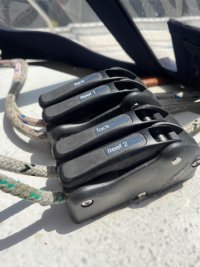I have an E34-type boat, so these are more general comments / not a reply to your original specific question about windspeeds.
TLDR: Consider only two reefs, with maybe the 2nd extra deep. Later on, consider setting up double-line slab reefing, so you can reef fully from the cockpit without going forward.
- It sounds like your sailmaker may not be familiar with the E32... you might see if anyone on this board can give you specs (luff height or %) for the different reefs on their own E32s. Perhaps you could give that straight to the sailmaker.
- I recently got a new main, and exact reef placement depended a bit on where the battens fell, which depended on whether I was getting full battens, etc. You might decide on batten style, if you haven't already, in case it affects how they lay out the reefs. I got a couple of full high up and a partial down lower, but mine's a bigger sail than yours.
- I was discouraged from getting a 3rd reef (but did it anyway -- covers offshore racing requirements in lieu of a trysail). The argument against boiled down to a combination of a) you will never use it (so far true) and can add it later if you want, and b) the extra reef cringle makes the sail stiffer and increases wear at the edges of the cringle up high. I have no opinion but do believe the folks that argued against, since one was a very trusted sailmaker in the bay area. The usual alternative to this is to i) get a normal two reefs and then, only if you later decide you want one, have the sailmaker add a 3rd later (which they can do fine), or ii) just getting deeper than normal 2nd and maybe 1st reef so you never need a 3rd. Given that many booms are not rigged for 3 reef clew lines, and since when you need that 3rd reef it will be way too hard to untie the 1st and run it through the flogging sail and then down and tie around the boom -- ughh -- presumably you would want to rig the 3rd reef clew line permanently, which is extra effort and expense. Or instead do a deeper 2nd (and maybe 1st) and you won't need the 3rd reef or associated clew line at all.
- I recently observed someone (Kalia, on this board) with 2-line reefing set up on their E34 -- so clew lines led through the boom and then aft to the cockpit, as well as lines from the reef tacks running down tot he mast base and then aft to the cockpit. I've done a lot of reefing (in fact, must do it underway a large fraction of the times I go out) and am very comfortable with it even singlehanded, but because I only have the clew lines rigged, I always have to go to the mast to secure the tack to the reefing horn on the gooseneck. Watching it done from the cockpit with separate lines for tack & clew was a revelation: just _so_ relaxed, and secure feeling, even in blustery wind. Given that you describe limited experience in > 15 kt winds, all I can say is you might consider it -- then that time you need it you will be more likely to do it early, since the task won't seem so large that you delay (we all know delay usually makes the situation harder, but we all do it...)
- PS: "Single line reefing", where the clew line is then run through the tack and aft, so you can winch n only one line and secure both the tack and clew... works poorly and I hate it. I would not do this -- high friction, and forces on tack/clew are not optimized since you have to use one line to do both. Sailmaker also recommended against it.
I second everyone else's comments above: I usually put in my 1st reef when the (apparent) wind is sustained over 15-17, and my second after it's sustained over 22 ish... but here the wind is pretty reliable in both speed and direction, so I often exceed a bit for a while knowing it won't go too much higher, and that the apparent wind will drop when I turn downwind for home. Like others, I tend to go by feel, not by wind gauge -- but now that I have a wind gauge I tend to look at it to see what speed that "time to reef" gust actually was

[By the way, those reefing decision are based on also running with a 90% jib that I don't furl.]

